Related Research Articles
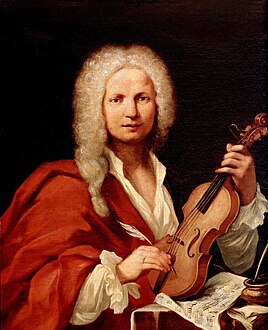
Antonio Lucio Vivaldi was an Italian Baroque composer, virtuoso violinist, teacher, impresario, and Roman Catholic priest. Born in Venice, the capital of the Venetian Republic, Vivaldi is regarded as one of the greatest Baroque composers, and his influence during his lifetime was widespread across Europe, being paramount in the development of Johann Sebastian Bach's instrumental music. He composed many instrumental concertos, for the violin and a variety of other musical instruments, as well as sacred choral works and more than fifty operas. His best-known work is a series of violin concertos known as the Four Seasons.
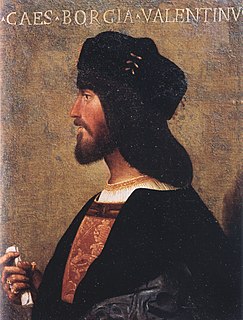
Cesare Borgia was an Italian cardinal and condottiero of Aragonese (Spanish) origin, whose fight for power was a major inspiration for The Prince by Niccolò Machiavelli. He was an illegitimate son of Pope Alexander VI and member of the Spanish-Aragonese House of Borgia.

Pope Pius IV, born Giovanni Angelo Medici, was head of the Catholic Church and ruler of the Papal States from 25 December 1559 to his death in 1565. Born in Milan, his family considered itself a branch of the House of Medici and used the same coat of arms. Although modern historians have found no proof of this connection, the Medici of Florence recognized the claims of the Medici of Milan in the early 16th century.
Andrea Gabrieli was an Italian composer and organist of the late Renaissance. The uncle of the somewhat more famous Giovanni Gabrieli, he was the first internationally renowned member of the Venetian School of composers, and was extremely influential in spreading the Venetian style in Italy as well as in Germany.
Pier Angelo Manzolli was a name used for the author of the book Zodiacus vitae, who is believed to be the Neapolitan poet Marcello Stellato, in Latin Marcellus Palingenius Stellatus.
Jacques Buus was a Franco-Flemish composer and organist of the Renaissance, and an early member of the Venetian School. He was one of the earliest composers of the ricercar, the predecessor to the fugue, and he was also a skilled composer of chansons.

Saint John the Baptist is a High Renaissance oil painting on walnut wood by Leonardo da Vinci. Likely completed between 1513 to 1516, it is believed to be his final painting. The original size of the painting was 69 by 57 centimetres. It is now exhibited at the Musée du Louvre in Paris, France.
Pierre Attaingnant was a French music publisher, active in Paris.

Richard Pynson was one of the first printers of English books. Born in Normandy, he moved to London, where he became one of the leading printers of the generation following William Caxton. His books were printed to a high standard of craftsmanship, and his Morton Missal (1500) is regarded as among the finest books printed in England in the period.

Elzevir is the name of a celebrated family of Dutch booksellers, publishers, and printers of the 17th and early 18th centuries. The duodecimo series of "Elzevirs" became very famous and very desirable among bibliophiles, who sought to obtain the tallest and freshest copies of these tiny books.

Angelo Emo was a Venetian noble and admiral, mostly known for being the last admiral of the Republic of Venice to lead the Venetian navy to battle. He attempted to introduce reforms based on the practices of the British Royal Navy, and led raids on Moorish targets along the Barbary Coast in retaliation for corsair attacks on Venetian-flagged shipping.

The House of Kastrioti was an Albanian noble family, active in the 14th and 15th centuries as the rulers of the Principality of Kastrioti. At the beginning of the 15th century, the family controlled a territory in the Mat and Dibra regions. The most notable member was Gjergj Kastrioti, better known as Skanderbeg, regarded today as an Albanian hero for leading the resistance against Mehmed the Conqueror's efforts to expand the Ottoman Empire into Albania. After the fall of the Principality and Skanderbeg's death in 1468, the Kastrioti family gave their allegiance to the Kingdom of Naples and were given control over the Duchy of San Pietro in Galatina and the County of Soleto, now in the Province of Lecce, Italy. Ferrante, son of Gjon Kastrioti II, Duke of Galatina and Count of Spoleto, is the direct ancestor of all male members of the Kastrioti family today. Today, the family consists of two Italian branches, one in Lecce and the other in Napoli. The descendants of the House of Kastrioti in Italy use the family name "Castriota Scanderbeg".

Ludovico Lazzarelli was an Italian poet, philosopher, courtier, hermeticist and (likely) magician and diviner of the early Renaissance.

Richard Field (1561–1624) was a printer and publisher in Elizabethan London, best known for his close association with the poems of William Shakespeare, with whom he grew up in Stratford-upon-Avon.

San Marco is a church in Milan, northern Italy.
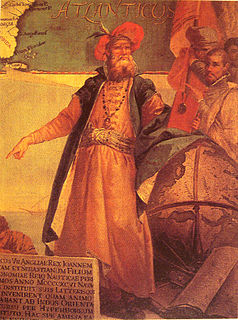
John Cabot was an Italian navigator and explorer. His 1497 voyage to the coast of North America under the commission of Henry VII of England is the earliest-known European exploration of coastal North America since the Norse visits to Vinland in the eleventh century. To mark the celebration of the 500th anniversary of Cabot's expedition, both the Canadian and British governments elected Cape Bonavista, Newfoundland as representing Cabot's first landing site. However, alternative locations have also been proposed.
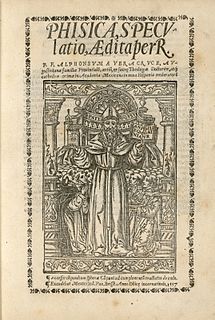
Giovanni Paoli, better known as Juan Pablos, a native of Lombardy, was the first documented printer in the Americas when he started printing in Mexico in 1539.

Giuseppe Maria Mazza was one of the leading sculptors of Bologna, Italy, in the late 17th and early 18th centuries. He was trained as a painter, but is best known for his fine sculptural work in terracotta and stucco.

L'Angelo Nocchiero is a marble sculpture in the symbolist style by Genovese sculptor Giovanni Scanzi, completed in 1886. It was commissioned by Giacomo Carpaneto, Cav. Mauriziano (1811-1878) as a monument for his family tomb in the Monumental Cemetery of Staglieno in Genova, Italy. Along with the sculpture for the Oneto Family sculpted by Giulio Monteverde in 1882, the Carpaneto monument has become one of the most recognisable icons of Staglieno, appearing on an official cemetery brochure in 2014. Famous people of the 19th century visited Staglieno and commented on the work, which depicts an angel, standing astride a small boat, beginning to secure the sails at the end of a journey.
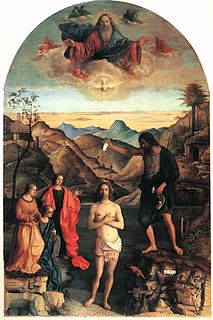
Baptism of Christ is a tempera painting on panel by Giovanni Bellini, dating to 1500–1502, and now located in the Chiesa di Santa Corona in Vicenza. It is signed IOANNES / BELLINVS on a rock in the lower left.
References
- ↑ Balsamo, Jean. Poetes Italiens de La Renaissance Dans La Bibliotheque de La Fondation Barbier-Mueller. de Dante a Chiabrera Librairie Droz, 2007, p. 179.
- 1 2 Von Habsburg, Maximilian. Catholic and Protestant Translations of the Imitatio Christi, 1425-1650: From Late Medieval Classic to Early Modern Bestseller Ashgate Publishing, Ltd., 2011. p. 74.
- ↑ Bellorini, Egidio Note sulle traduzioni italiane delle "Eroidi" d'Ovidio, anteriori al rinascimento E. Loescher, 1900. p. 84.